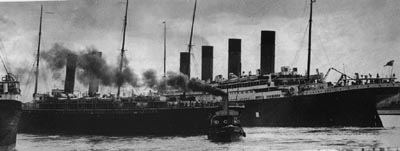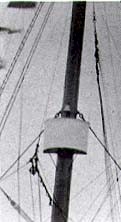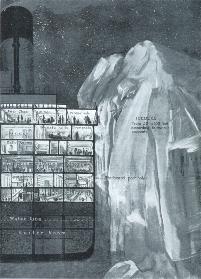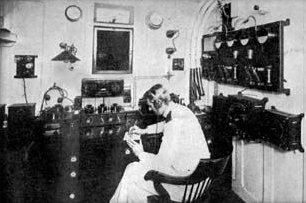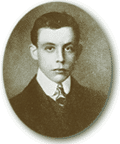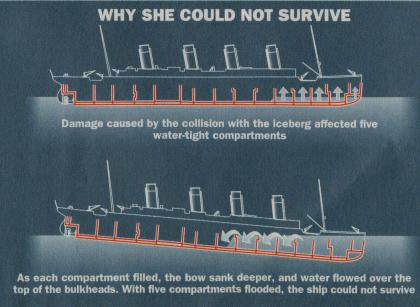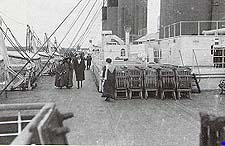
"Men you have done your full duty. You can do no more. Abandon your Cabin. Now it's every man for himself."
|
|
|
|
TITANIC'S MAIDEN VOYAGE The Titanic was finally ready for her departure on April 10 1912. Delays had occurred as a result of the Olympics collision with the HMS Hawke in September 1911 and in February the Olypmic also lost a propeller. The owners wanted to see the Olympic operational before the Titanic. Also that year there was a coal strike. A severe problem for any transatlantic liner because ships like the Titanic would consume over 600 tons of coal a day. To partially solve the problem, coal was taken from other ships like the Adriatic and Oceanic to stock up the coal bunkers for the Titanic's voyage. Titanic nearly collides with SS New York At noon on the 10 April 1912 the Titanic set sail from Southampton. Immediately, there was a potential disaster. There was a near collision with the steamer New York. The New York being much smaller than the Titanic was sucked in to her wake as the Titanic giant triple screw propellers rotated. The New York's mooring snapped and was dragged towards the port side of her. This is exactly what happened to her sister ship when she collided with the HMS Hawke. The Titanic sailed to Cherbourg in France and later to Queenstown in Ireland to pick up additional passengers. There were 1320 passengers and 907 crew. The first few days of the voyage were uneventful. Captain Smith steadily increased speed day by day. The ship covered 386 miles on the first day, 519 the second and 546 miles the third. It was reported that Smith would have increased the mileage day by day. The passengers were unaware that one of the coalbunkers had been on fire since departure. Situations like this were common because coal dust which is very flammable, got everywhere, not just in the air but in machinery. As the slightest spark could ignite the whole bunker, coal had to be kept sufficiently damp to prevent fires from starting.
The fire on board the Titanic took until Sunday night to be put out. The ship sailed on. TITANIC RACES TOWARDS THE ICEBURG |
The Titanic, although a floating palace, did not have advanced warning systems that we have today. The Marconi wireless was ahead of its day and was new to most operators. A new era of message transmission was born. Still, the Titanic had a back up system, the six lookout guards whose job it was to stand in the crows nest and keep a vigil look out for passing icebergs or other objects that may cause harm. Frederick Fleet's Lookout Post High up in his observation port, that cold night, Frederick Fleet gazed out across the glistening sea searching for icebergs and sheet ice. It was the fifth night of the voyage. All so far had been quite. His watch had almost come to an end. The Titanic cut the waves like a knife through butter at a steady speed of 22.5 knots. It was 11.40 p.m. 14 April 1912.
Frederick Fleet (aged 24) Suddenly Fleet observed an iceberg heading straight for the ship. He urgentyly rang the bell three times and phoned the Bridge. He told them what he had seen. "Iceberg right ahead!" After he had given the signal, Fleet and his colleague Reginald Lee waited for the necessary action to be taken. Minutes seemed to pass but in reality it was only thirty-seven seconds before the ship began to swing portside. At first it looked as if the ship had just missed the berg but there was a noticeable sudden tell tale. How wrong could they be? First Officer William M. Murdoch was on watch on the Bridge. The following manoeuvres were his responsibility. He ordered the engines to stop and go full speed astern and quickly closed all watertight doors. Captain Smith joined the bridge and wanted a report as to what had happened. "An iceberg Sir. I hard a starboarded and reversed the engines and I was going to hard-a-port around it, but she was too close. I couldn't do anymore."
The emergency doors had been closed in practice because of the scale of the damage but little use they would do except to marginally slow the rate of sinking. Captain Smith accompanied Thomas Andrews, the designer of the ship to carry out structural surveys. Andrews knew every inch of the ship and had been carrying out inspections of her since he boarded with a view to making recommendations to the White Star Line upon his return about improvements that he felt should be made. As a result of seeing water in the forepeak, No. 1 and No. 2 hold, boiler rooms No. 5 and 6 and the mailroom, Andrews calculated that there must be a 300-foot gash, five compartments were already flooded. The design allowed the Titanic to float with any three of her five compartments flooded at any one time: but five meant certain sinking. Sinking was a mathematical certainty. The only uncertainty was the rate of water intake and therefore whether the ship would lastan hour or an hour and a half. With the fate of the Titanic sealed, Captain Smith ordered the lifeboats to be uncovered. Titanics Wireless Room - Marconi Wireless
John George Philips Philips, the ships wireless operator was listening to messages being received from other ships around. Captain Smith told him what had happened: "We've struck an iceberg……You'd better send out a call for assistance, but don't sent it until I tell you." A few moments later Captain Smith gave the order. At 12.15 the International call of distress CQD was tapped out followed by the Titanic's MGY call letters so to identify the Titanic to listeners. The nearest ship to the Titanic was the Californian only ten miles away. She heard the signal over the wireless but the person receiving the signal was not fully conversant with their system and so did not pick up the full message and appreciate its full meaning. Click here to see one of the many SOS messages sent The passengers on the Titanic initially did nothing. The Titanic was belived "unsinkable" and so talk of an iceberg and lifeboats did not enter the equation. Some passengers carried on with playing cards, others sang songs especially in third class as they particularly were kept uninformed. By 12.10 a.m. water had flooded into F Deck. The first lifeboats were being lowered but clearly if filled they could only carry 1, 178 people. There were 2,207 people on board. Many of the passengers and crew would not have known or even thought about the lifeboat capacities. However, confusion and panic had already begun. Click here to see the order that the boats were lowered Second Officer Charles Lightoller (also known as "Lights") was in charge of the portside evacuation. No. 7 Boat was lowered at 12.45. By then water had already reached E Deck. The Cunarder Carpathia was only 58 miles away. She picked up Titanic's CQD and quickly replied she was on her way but she would arrive too late.
Harold Bride (above) the second wireless operator suggested to Philips that they should use the new International Convention signal SOS. The Titanic was the first ocean liner to use "Save Our Souls". Captain Smith ordered rockets to be fired at five or six minute intervals. The Californian saw the rockets and thought it was strange that a ship would fire rockets at night, but did nothing more. Officer Boxhall and Quartermaster Rowe released more rockets. They enquired to Captain Smith how serious the situation. "Mr. Andrews tells me that he gives her from an hour to an hour and a half." A huge evacuation had to commence. Lightoller only allowed women and children in his boats on the portside whilst Murdoch would allow anybody providing there was room. Women and children should have taken priority to ensure their safety. Whilst the first and second class passengers were required to assemble on the boat deck, the third class were confined in their sector of the boat and not given instructions for some time. They were be allowed access to the boat deck at 12.30 a.m. Orders were given to release the third class and bring them to the boats. However, most of the third class passengers were not familiar with the giant liner. Her passages, corridors and decks must have been a maze to them. Some would have inevitable got lost and spent their last few hours walking aimlessly around the ship. Third class steward, John Hart organised parties of passengers and personally escorted them to the boat deck. Once he got there he would return to collect some more. 1.45 a.m. Philips begged the Carpathia to "Come as quickly as possible, old man, engine room filling up to the boilers". Water had indeed started to engulf the forward well deck around the cranes, the hatches and the foot of the mast. By this time, the Titanic had developed a very serious list. Ten minutes passed. Boat No. 4 was lowered. It was only 15 foot to the water edge. With only one boat left Collapsible D. Lightoller quickly recognised the passengers still on board and that most were doomed. Other officers and he had withdrawn firearms from the store previously and decided to take no chances. They formed a ring fence around the boat and only let legitimate passengers get in to the boat. The boat was lowered at 2.05 a.m. Captain Smith realised that nothing more could be done. "Men you have done your full duty. You can do no more. Abandon your Cabin. Now it's every man for himself." Philips continued to work but Captain Smith released him from his duties. He still carried on. With minutes to go a few officers tried to release collapsible boats attached to the Officers Quarters. Most passengers were trying to reach the stern, which by now was sharply rising. Chandeliers throughout the Titanic hung on obscure angles. Tables and chairs were slid along rooms and the sound of smashing plates from the galleys. Thomas Andrews awaited his fate in the first class Smoking Room. He was not wearing his lifebelt. He knew the end was near. Outside the Titanic Band still played on. The Bandleader, Wallace Hartley conducted Ragtime whilst the evacuation continued. The Titanic's lights went out, came on again briefly but finally extinguished at 2.20 a.m. The tilt of the stern grew. The forward funnel toppled over with a mighty crash. A thousand passengers clung to objects on the stern for security. For a moment, the Titanic stood perpendicular in the water. Her propellers glistened by the moonlight. Suddenly she was gone. There was an erie silence amongst the survivors in the lifeboats. They could not believe that the Titanic had sunk before their very eyes and that it had cost the lives of so many loved ones. The Californian's Second Officer Stone watched the ship slowly disappear. At 2.20 a.m. he reported the missing ship to his captain and carried on with his watch
|
Back to the top
